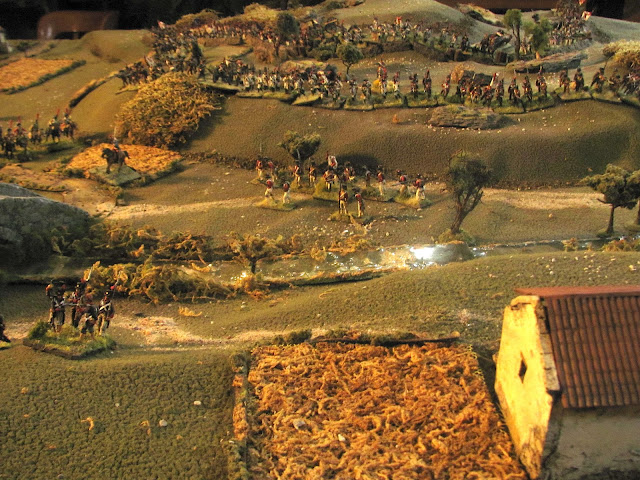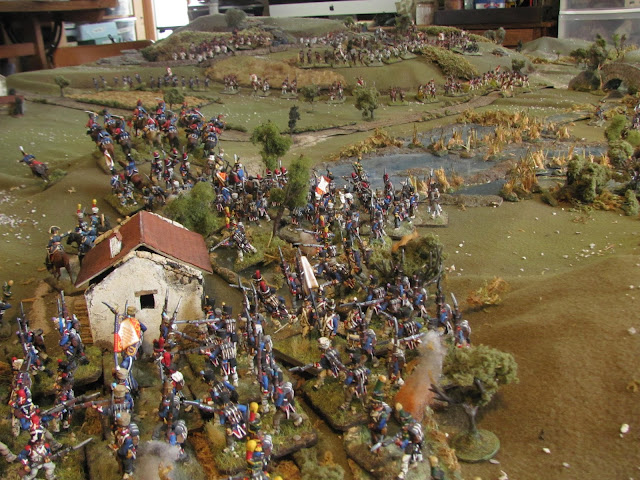Last week Brian North and I played out a new scenario by Brian, the Battle of Zalamaea. The following is extracted from Brian’s excellent background on the battle:
Zalamea is the second of the long series of duels between Ballesteros and elements of 5th Corps taking place in Extremadura and Huelva in 1810 and 1811, on the borders of Andalucia. As with the whole of this campaign, accounts are very sparse – and contradictory. Most modern sources (e.g. Esdaile and De Valle) follow Arteche and Lapène who say that Ballesteros tried to prevent the French crossing the Rio Tinto, while Priego, the modern official history, follows Toreno in saying Ballesteros was himself caught while in the process of crossing the river – a precursor of the disaster at Alba de Tormes to befall the Army of the Left the following year. Esdaile follows Lapène in saying that the Spanish attempted to stave off the French from the shelter of a ridge studded with rocky outcrops and difficult to access, which was to right of the town, presumably behind the river. This suggests the crossing of the Rio Tinto near Nerva – even today the only bridge in the vicinity – where there is a rocky ridge on the bank defended by the Spanish. Both Esdaile and De Valle, further state that Ballesteros consolidated his position, but whether that means entrenchments is unclear. There is no information about the course of the battle, or even when it started. De Valle, who gives most detail, says that Moriter raced ahead of the main body of the 5th Corps with 10th Hussars and ‘three regiments of infantry.’ He cites the Granada Gazette’s that the 34th Line, a battalion of 100th Line under Captain Lasalle and the 10th Hussars all distinguished themselves in the action. The only point clear is that Ballesteros was defeated and retreated.
We played this using the Over the Hills ruleset with my 1/72nd scale toy soldiers on a 6’ X 9’ table.
 |
| The scenario map - shaded areas are steep rocky terrain, slow-going and inaccessible to cavalry. The Spanish begin below the river while the French enter via Nerva. |
1. The Battlefield
The Spanish begin in a strong position on high ground (left of picture) opposite the bridge crossing the Rio Tinto with a small force of irregulars in skirmish order on the French side of the bridge. The river is relatively shallow and fordable at numerous points but the French need to discover those fords on their arrival.
2. Spanish on the high ground
View from Nerva with the majority of the Spanish on the far bank.
3. Spanish irregulars on the French side of Rio Tinto
4. Cavalry in support
5. Ballesteros in two lines
Ballesteros arrays his two brigades (one under his immediate control and the other under the control of his lieutenant, Menacho). Menacho has his skirmishers (Covadonga) arrayed in front. The entire hill is very steep and rough, making movement slow and difficult and impassable to cavalry. In the end this hampered the attack more than the defence.
6. Ballesteros directs the defence
Ballesteros surrounded by his ADC’s and priests. A big challenge for the Spanish was for Ballesteros to successfully command the entire battle while at the same time command his own massive brigade.
7. Spanish right, second line
8. Spanish left second line
The entire second line begins in entrenchments, making it a powerful position for the Spanish to fall back upon.
9. Overview
10. French debouch from Nerva
Mortier’s arrival is staggered and at the whim of the dice. Fairly rapidly, however, the 10th Hussars arrive followed by the three battalions of the 34th Line, under the command of Rémond.
11. Hussars seek ford
The Hussars fan out to the south in search of a ford, with the 34th close behind.
12. Spanish dragoons charge the French host - sort of
The Hussars rapidly find two fords but with the 34th with only one battalion across Ballesteros sends his two small dragoon units (Lusitania and Sagunto) to slow down the crossing. Sagunto scatters the hussars away from the river, but then balks at charging the massed French columns. The Hussars quickly form up and countercharge the Spanish, now trapped on the French side of the river.
13. Cavalry clash on the banks of the Rio Tinto
The conclusion was foregone as Sagunto is crushed by the French countercharge.
14. Ballesteros redeploys his lines
Seeing the French approaching from the south, Ballesteros starts the long and slow process of redeploying to that side of the high ground (right). He sends his skirmish troops down to the foot of the hill (but within a safe distance to evade into the rocky terrain) while two of his batteries limber up and crawl across the hillside. Fortunately the long French approach has bought him a lot of time to redeploy.
15. Dembowski's brigade and the 3/100th arrive
With a delayed arrival, Dembowski finally arrives with the three battalions of the 88th Line, supported by the 3/100th. Mortier sends these to attack the Spanish front, hopefully pinning Ballesteros’ front line (under Menacho) while Rémond develops his attack on the Spanish right.
16. French columns pour across the fords
The rest of Rémond's command, the three battalions of the 40th Line, follow the 34th as they cross the Rio Tinto. However Rémond’s attack has been slowed somewhat by the sacrifice of Sagunto.
17. Lusitania retreat to threaten Dembowski
The remaining Spanish dragoons are ordered back to the bridge to impede Dembowski’s crossing. This they are able to successfully do in the narrow bit of bank between the bridge and the high ground, as Dembowski is forced to close up his columns to ward off the Spanish horse, making them nice juicy targets for Menacho’s half battery of artillery.
18.View from the Spanish lines of Dembowski’s attack
19. Dembowski urges his columns forward
20. Hussars drive off the Spanish skirmish line as they cover Rémond's advance
The Spanish skirmishers evade back to the high ground while a half battery fires ineffectually at the dispersed French cavalry. However, with the Spanish now safely on the rocky ridge and the Lusitania Dragoons out of reach the Hussar’s role in this battle comes to a conclusion.
21. 2/88th advance against Navarra
Dembowski finally gets one of his battalions in action, but they are badly savaged by Navarra’s volleys and cannon fire.

22. Menacho begins to withdraw
Seeing Dembowski's attack bogged down, Menacho begins to withdraw to the entrenched positions vacated by some of Ballesteros' brigade, which have also started to withdraw.
23. Rémond's attack goes in
Meanwhile a first attack on the Spanish right by two battalions in column is crushed with the 2/34th routed and the 3/34th destroyed by devastating fire by the Spanish artillery and a stout defence by the entrenched Spanish. Ballesteros pulls the battered Princesa out of the line and brings in Oviedo.
24. Overview
In this overview, on the left you can see the Spanish lines thinning as they begin to pull their troops back in preparation for withdrawal (the scenario calls for the Spanish to hold until Turn 10 and then withdraw). The battery on this flank cannot be withdrawn because of the terrain. On the right bottom Ballesteros desperately tries to hold off the repeated French attacks in column, cycling in fresh troops in the lulls between attacks as he keeps the French from blocking his line of retreat.
25. 3/34th presses home a second attack
Oviedo is in turn pulled out of the line and Princesa, now rallied, steps back in to meet a second attack by the 3/40th. However the Spanish are very hard to budge!
This second attack is also driven off, this time with Rémond, leading from the front, falling in combat.
The Spanish line holds but Ballesteros, in the trenches with Princesa, takes a French musket ball and is laid low as well, with both sides now losing key commanders.
26. Menacho's battery firing canister
The battle comes to a rapid conclusion with two very large bangs. Menacho’s battery, abandoned as his battalion withdraws to the entrenched lines, drives off an attack by Dembowski with a devastating round of canister that shatters the ranks of the 2/88th.
27. French receive the same treatment on Spanish right
At the same time the 3/88th, marching to the support of Rémond’s attack on the Spanish right, marches directly in front of a Spanish battery and takes a similar pounding, thus breaking Dembowski’s brigade.
28. Battle end
With Dembowski’s brigade broken and Rémond’s wavering, the Spanish manage to hold their position, with the loss of only one unit, the Santiago Dragoons, albeit with the tragic loss of their commander as well. (Ballesteros will likely survive his wounds to fight again as Brian has more of these encounters in his to-do box.)
The French suffered the loss of two battalions broken, one routed and the loss of their most promising brigadier. However we decided the nut was too hard to crack, mostly because the terrain crippled any French attack that went in, so there will be a minor rewrite and then we will try this again.


























